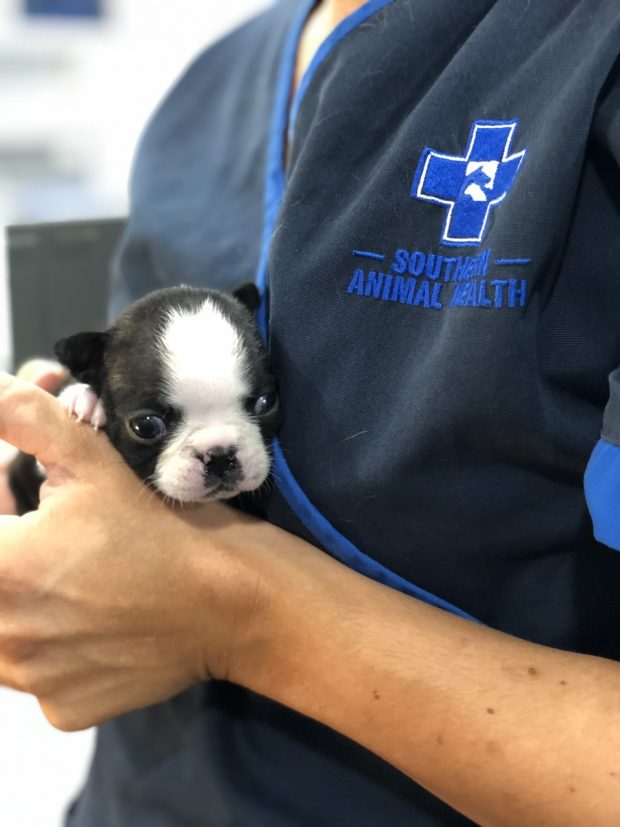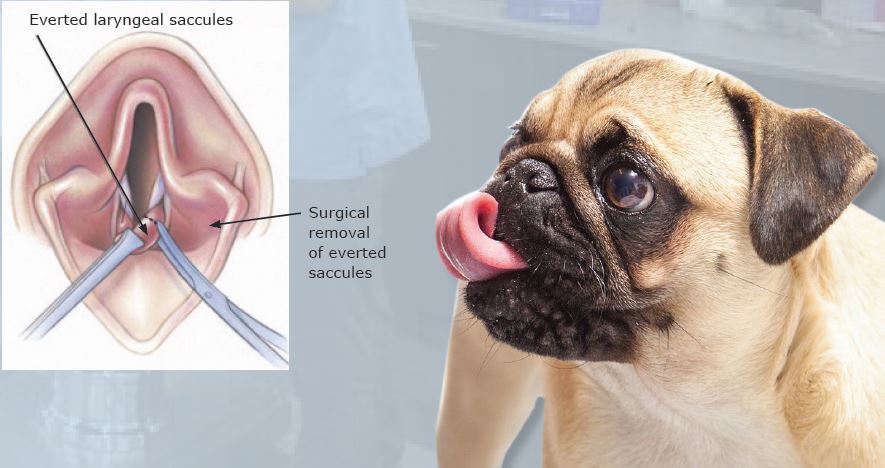We can correct some of the changes that occur as they get worse with time, others we can’t. It is the changes that we can’t correct that lead to a decreasing prognosis for improving quality of life if surgery is delayed beyond 6-12 months of age, and especially if delayed beyond two years of age.
The turbulent airflow causes 7 concerns:
1. Everted laryngeal saccules (stage 1 laryngeal collapse)
2. Redundant pharyngeal mucosa
3. A thickened soft palate exacerbating the concerns of what was initially just a long soft palate
4. Occasionally chronic intermittent regurgitation
5. Stage 2 and 3 laryngeal collapse. (Progressive collapse of the voice box)
6. Enlarged tonsils
7. Tracheal collapse
Everted Laryngeal Saccules
There are two small membranes located inside the larynx. The turbulent airflow caused by stenotic nares plus or minus the elongated soft palate cause these saccules to thicken, swell and eventually evert. As you can imagine, these narrow the airway resulting in increased snoring, decreased oxygen supply and exacerbating the whole Brachycephalic Obstructive Airway Syndrome (BOAS) process. (If you have noticed your dog slowly worsening with their snoring, this is likely happening). The good news is these can be easily and quickly removed if they are causing a significant problem.
Here are the general rules that we have encountered in our clinic:
- If the soft palate and nares are attended to early (8 months for Frenchies, Pugs and Bostons, and 10 months for Aussie and British Bulldogs) it’s very rare for saccules to swell and evert later in life.
- Most brachycephalics will only start to have this problem post 12 months of age – with the exception of French Bulldogs. Unfortunately Frenchies are very prone to everted laryngeal saccules even at an early age.
- If at 8 months of age a Frenchie has no snoring at all, there may still be about a 10% chance saccules may be swollen enough to consider removal. If there is moderate to severe snoring by this age the chance of significant swelling rises to about 50%, and increases quickly from there.
Redundant Pharyngeal Mucosa
The lining at the back of the pharynx (mouth) is called mucosa. The turbulent airflow results in this lining thickening and folding with time. As you can imagine, this reduces the space available at the back of the mouth, exacerbating the Brachycephalic Obstructive Airway Syndrome (BOAS) concerns with time.
The bad news is this cannot be corrected, and the worse it gets the less chance eventual surgery will give as good a long term result as early intervention. This is a major reason, along with stage 2 and 3 laryngeal collapse, that we strongly recommend early assessment and if appropriate, intervention.
Thickened Soft Palate
The turbulent airflow also causes an already elongated palate to thicken with time. Unfortunately some palates are naturally quite thick, even at six months of age, but this is relatively rare at this time. Beyond one year the chances of a palate thickening increase significantly.
It is most important to consider thinning a really thick palate, not just shortening. The reality is that most surgeons that may do palate shortening do not have the skills to thin them if this is also required. Hence ideally you should seek a surgeon that is experienced and skilled in thinning a palate if required, not just shortening it.
Stage 2 and 3 Laryngeal Collapse
Unfortunately some dogs who appear to be OK, seem to worsen with snoring and respiratory noise upon exercise as time goes by, and occasionally this occurs quite quickly. Some of these dogs are at risk of laryngeal collapse. This occurs when the abnormal airflow, and secondary changes of everted laryngeal saccules and redundant pharyngeal mucosa, lead to pressures that result in the arytenoids (two cartilages that form part of the larynx), permanently collapsing in on themselves, further narrowing the airways and restricting oxygen. This is bad news. These cannot be corrected and are a reason for euthanasia in some individuals suffering from this.
Enlarged Tonsils
Ongoing inflammation at the back of the mouth due to turbulent airflow causes the tonsils to become enlarged. This results in further occlusion to the space at the back of the throat.
Tracheal Collapse
The same negative pressure concerns resulting in the above problems can lead to tracheal collapse in some dogs. This occurs when the trachea weakens and collapses in on itself further restricting air movement. Like 3rd stage laryngeal collapse, this is very concerning.



